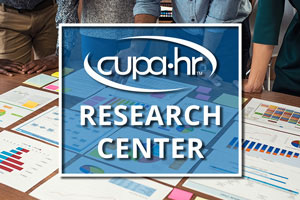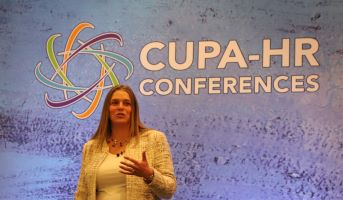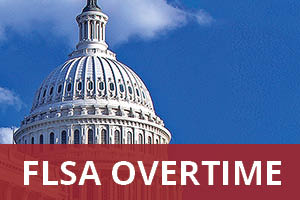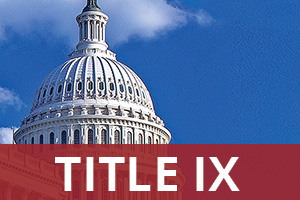
by Julie Burrell

In his recent webinar for CUPA-HR, Rahul Thadani, senior executive director of HR information systems at the University of Alabama at Birmingham, answered some of the most frequently raised questions about AI in HR. He also spoke to the most prevalent worries, including concerns about data privacy and whether AI will compete with humans for jobs. In addition to covering the basics on AI and how it works, Thadani addressed questions about the risks and rewards of using AI in HR, including: How can AI speed up productivity now? What AI tools should HR be using? How well is AI integrated into enterprise software? What are the risks and downsides of using AI? What role will AI play in the future of HR? Thadani also put to rest a common fear about AI: that it will replace human jobs. He believes that HR is too complex, too fundamentally human a role to be automated.
 The workforce retention challenges higher education has been experiencing post-pandemic might just be letting up. A recent trend analysis of turnover data collected in CUPA-HR’s annual higher education workforce surveys found that in 2023-24, voluntary turnover rates for faculty and staff trended downward for the first time in three years.
The workforce retention challenges higher education has been experiencing post-pandemic might just be letting up. A recent trend analysis of turnover data collected in CUPA-HR’s annual higher education workforce surveys found that in 2023-24, voluntary turnover rates for faculty and staff trended downward for the first time in three years. 


 On April 29, the U.S. Equal Employment Opportunity Commission issued final guidance on workplace harassment and discrimination titled “Enforcement Guidance on Harassment in the Workplace.” The guidance clarifies existing employer obligations to address workplace discrimination and aims to assist employers in recognizing, managing and preventing in-person and online workplace harassment.
On April 29, the U.S. Equal Employment Opportunity Commission issued final guidance on workplace harassment and discrimination titled “Enforcement Guidance on Harassment in the Workplace.” The guidance clarifies existing employer obligations to address workplace discrimination and aims to assist employers in recognizing, managing and preventing in-person and online workplace harassment.  Spring had sprung in Minneapolis, Minnesota, at the CUPA-HR Spring Conference, where more than 400 higher ed HR pros had the opportunity to connect with and learn from some of the brightest HR leaders in higher education. From three dynamic keynotes to 29 interactive concurrent sessions, the conference provided a platform to engage in meaningful discussions, network with peers and gain valuable knowledge to help navigate the dynamic profession of higher ed HR.
Spring had sprung in Minneapolis, Minnesota, at the CUPA-HR Spring Conference, where more than 400 higher ed HR pros had the opportunity to connect with and learn from some of the brightest HR leaders in higher education. From three dynamic keynotes to 29 interactive concurrent sessions, the conference provided a platform to engage in meaningful discussions, network with peers and gain valuable knowledge to help navigate the dynamic profession of higher ed HR.  “Wherever we go, we are CUPA-HR.” That’s what CUPA-HR President Andy Brantley reminded members at the recent Spring Conference in Minneapolis. Though institutions differ in mission and scope and despite daily crises that threaten to divert attention from long-term goals, CUPA-HR members live their values every day. The keynote speakers struck a similar theme, encouraging attendees to align their internal values with work, tapping into courage, care and a sense of calling. Here are the key takeaways.
“Wherever we go, we are CUPA-HR.” That’s what CUPA-HR President Andy Brantley reminded members at the recent Spring Conference in Minneapolis. Though institutions differ in mission and scope and despite daily crises that threaten to divert attention from long-term goals, CUPA-HR members live their values every day. The keynote speakers struck a similar theme, encouraging attendees to align their internal values with work, tapping into courage, care and a sense of calling. Here are the key takeaways.  On April 23, the Department of Labor (DOL) issued the highly anticipated final rule to alter the overtime pay regulations under the Fair Labor Standards Act (FLSA). The rule increases the minimum salary threshold to $43,888 on July 1, 2024, and then to $58,656 on January 1, 2025. The rule also implements automatic updates to the threshold that will occur every three years. Institutions will need to make all necessary adjustments by July 1, 2024, in order to be in compliance with the final rule.
On April 23, the Department of Labor (DOL) issued the highly anticipated final rule to alter the overtime pay regulations under the Fair Labor Standards Act (FLSA). The rule increases the minimum salary threshold to $43,888 on July 1, 2024, and then to $58,656 on January 1, 2025. The rule also implements automatic updates to the threshold that will occur every three years. Institutions will need to make all necessary adjustments by July 1, 2024, in order to be in compliance with the final rule.  On April 19, the Department of Education (ED) released the text of the highly anticipated Title IX final rule. The final rule expands protections against sex-based discrimination to cover sexual orientation, gender identity, and pregnancy or related conditions. The rule also revokes both the Trump administration’s ban on campuses using a single person to investigate and adjudicate Title IX complaints and the Trump mandate regarding cross-examination of complainants. Institutions will need to be in compliance with the final rule by August 1, 2024.
On April 19, the Department of Education (ED) released the text of the highly anticipated Title IX final rule. The final rule expands protections against sex-based discrimination to cover sexual orientation, gender identity, and pregnancy or related conditions. The rule also revokes both the Trump administration’s ban on campuses using a single person to investigate and adjudicate Title IX complaints and the Trump mandate regarding cross-examination of complainants. Institutions will need to be in compliance with the final rule by August 1, 2024.  In his recent webinar for CUPA-HR, Rahul Thadani, senior executive director of HR information systems at the University of Alabama at Birmingham, answered some of the most frequently raised questions about AI in HR. He also spoke to the most prevalent worries, including concerns about data privacy and whether AI will compete with humans for jobs. In addition to covering the basics on AI and how it works, Thadani addressed questions about the risks and rewards of using AI in HR, including: How can AI speed up productivity now? What AI tools should HR be using? How well is AI integrated into enterprise software? What are the risks and downsides of using AI? What role will AI play in the future of HR? Thadani also put to rest a common fear about AI: that it will replace human jobs. He believes that HR is too complex, too fundamentally human a role to be automated.
In his recent webinar for CUPA-HR, Rahul Thadani, senior executive director of HR information systems at the University of Alabama at Birmingham, answered some of the most frequently raised questions about AI in HR. He also spoke to the most prevalent worries, including concerns about data privacy and whether AI will compete with humans for jobs. In addition to covering the basics on AI and how it works, Thadani addressed questions about the risks and rewards of using AI in HR, including: How can AI speed up productivity now? What AI tools should HR be using? How well is AI integrated into enterprise software? What are the risks and downsides of using AI? What role will AI play in the future of HR? Thadani also put to rest a common fear about AI: that it will replace human jobs. He believes that HR is too complex, too fundamentally human a role to be automated.